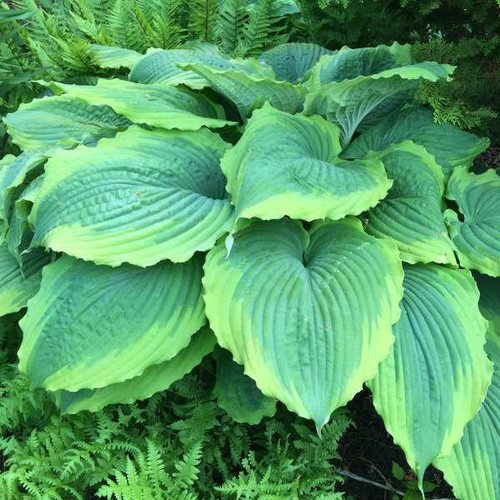Product Description
'Gold Standard' Hosta (Banyai 1976) (25) bare root clumps
Large.
An ever-popular, classic hosta; large, ovate leaves have dark green margins
Leaf centers emerge light green in the spring and become progressively more gold towards early summer; morning sun will enhance the gold color
Pale lavender flowers appear on 30" scapes in midsummer
Forms a large mound of foliage, making it ideal as a specimen or in mass plantings.
Height:20 Inches
Spread: 36 inches
Scape Height: 30 Inches
Hardiness Zones: 3,4,5,6,7,8,9
Flower Color: Purple shades
Foliage Color: Variegated
Part Shade (4-6 hrs. Direct Sun) to Full Shade (< 4 hrs. Direct Sun)
Average to Consistent Water Needs
Average to Fertile Soil Quality
Bloomtime: Midsummer to Late Summer
Attracts Hummingbirds
Growth Rate: Medium
Border Plant, Mass Planting, Cut Foliage, Easy To Grow, Edging, Attractive Foliage, Specimen, Focal Point
Elevate Your Shade Garden with the Radiant 'Gold Standard' Hosta!
Hosta 'Gold Standard' is a classic and highly sought-after hosta cultivar renowned for its stunning golden foliage and adaptability to various light conditions. This vigorous perennial forms a large mound of heart-shaped leaves, adding a touch of sunshine and elegance to shady gardens, borders, or containers.
'Gold Standard' is a beloved hosta that has been a garden staple for decades. Its large, heart-shaped leaves emerge with a chartreuse center and dark green margins in spring, gradually transitioning to a vibrant golden yellow as the season progresses. The contrasting colors create a striking visual effect that brightens up shady areas. In midsummer, the plant sends up tall scapes bearing pale lavender flowers, adding a touch of delicate beauty to the display. This hosta is a vigorous grower and requires minimal care, making it a favorite among gardeners of all levels.
Details:
- Mature Size: 22 inches tall, 36 inches wide
- Foliage Color: Chartreuse center with dark green margins, maturing to golden yellow
- Flower Color: Pale lavender
- Bloom Time: Midsummer
- Growth Habit: Mounding, clump-forming
- Light Needs: Part shade to full shade (tolerates some morning sun)
- Soil Needs: Fertile, moist, well-drained soil
- Hardiness Zones: 3-8 (USDA)
- Special Features: Large leaves, vibrant color, sun tolerant, attractive flowers, low maintenance
Planting:
- Timing: Plant in spring or fall for best results.
- Location: Choose a shady or partially shaded location with fertile, moist, well-drained soil. 'Gold Standard' can tolerate some morning sun, but avoid harsh afternoon sun, especially in hot climates.
- Soil Preparation: Amend the soil with compost or other organic matter to improve drainage and moisture retention.
- Spacing: Space plants 3-4 feet apart to allow for adequate growth.
- Planting Depth: Plant the crown (where the leaves emerge from the roots) at the same level as the soil surface.
- Watering: Water thoroughly after planting and regularly until it is established.
Care:
- Watering: Hostas prefer consistently moist soil. Water regularly, especially during dry spells.
- Fertilizing: Apply a balanced fertilizer in spring to promote healthy growth and flowering.
- Mulching: Apply a layer of mulch around the plants to retain moisture, suppress weeds, and protect the shallow roots.
- Pruning: Remove any faded or damaged leaves throughout the growing season. Cut back the flower stalks after blooming to encourage foliage growth.
- Pest and Disease Control: 'Gold Standard' is generally pest and disease resistant, but watch for slugs and snails, which can damage the foliage.
Uses in the Garden:
- Shade Gardens: Ideal for adding a bright and cheerful touch to shade gardens.
- Woodland Gardens: Thrives in woodland settings, complementing other shade-loving plants.
- Borders and Edging: Creates a beautiful border along walkways or flower beds.
- Groundcover: Can be used as a groundcover in shady areas.
- Containers: Can be grown in containers, adding a touch of elegance to patios and balconies.
- Mass Plantings: Plant in groups for a dramatic display of golden foliage.
Elevate your shade garden with the radiant foliage and easy-care nature of Hosta 'Gold Standard'!
Other Details
The most important part of the plant is its root system. Healthy roots are the foundation of a healthy, vibrant plant. The type of plug container used is based on the specific needs of the plants. Perennials offered as bare root traditionally perform better when planted as bare root.Planted in a specialized mix, potted plants have well established root systems. Top growth stage will vary depending on the current life cycle and time of year when shipped. In Winter and early Spring dormant plants may be shipped. Dormant plants may be planted right away, even before the last frost date.
Most bare root varieties are field grown for at least one season, though Hemerocallis and Hosta are grown for two seasons. The bulk of the soil is removed during the harvesting process and the tops of most varieties are trimmed back to the crown. They are graded, packed in shredded aspen or sphagnum moss and stored in freezers until ready to be shipped.
See our Container Sizes and Bare Root Perennials pages for more information.
Plant information and care is provided in the Overview section, Plant Genus Page and general information is provided in the Planting Care & Guides. Additional questions can be asked on each Plant page.
Plant Spacing: Using the maximum mature spread or width of a plant to guide spacing, ensures space to grow to full size. To fill an area sooner, plant them closer together. Just remember, future thinning or transplanting may be needed.
Water: Keep a close eye on newly planted perennials, especially throughout the first growing year. Most early plant loss is due to too much or too little water!






















